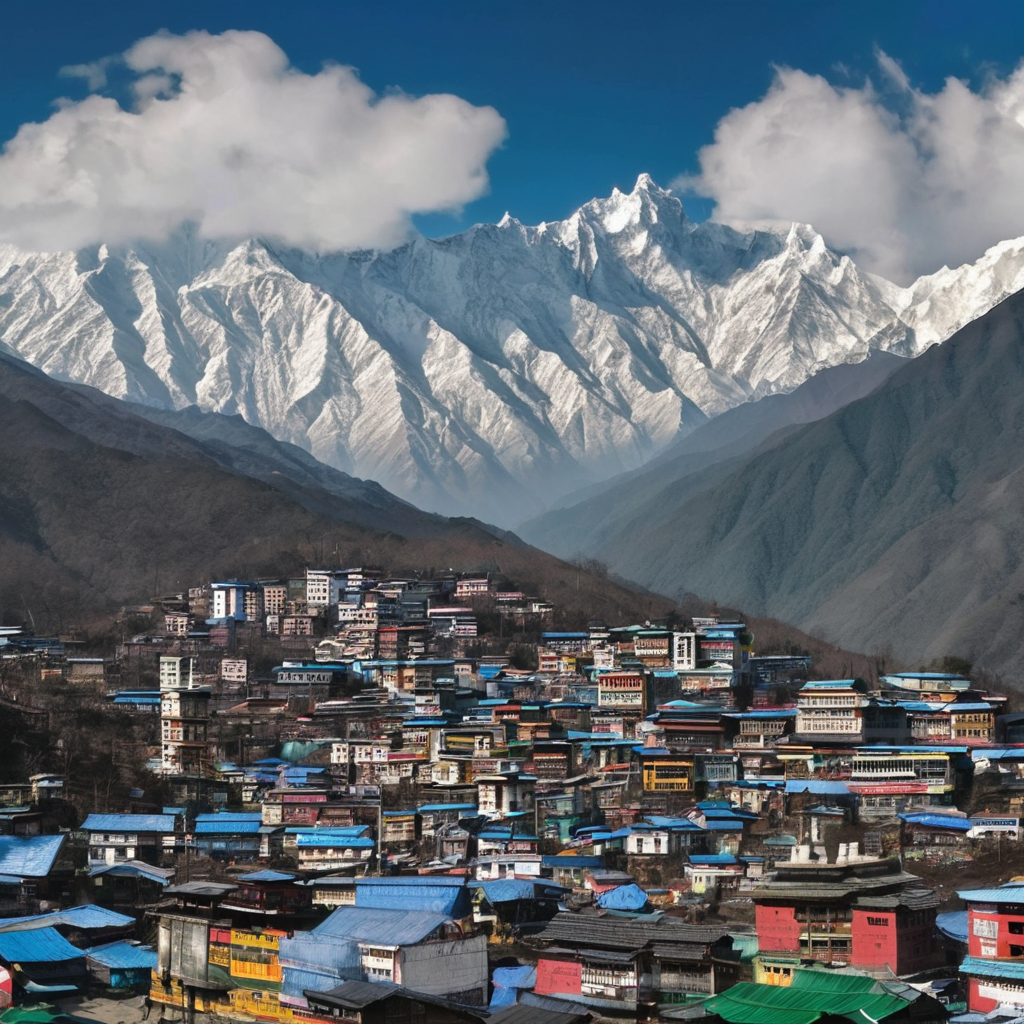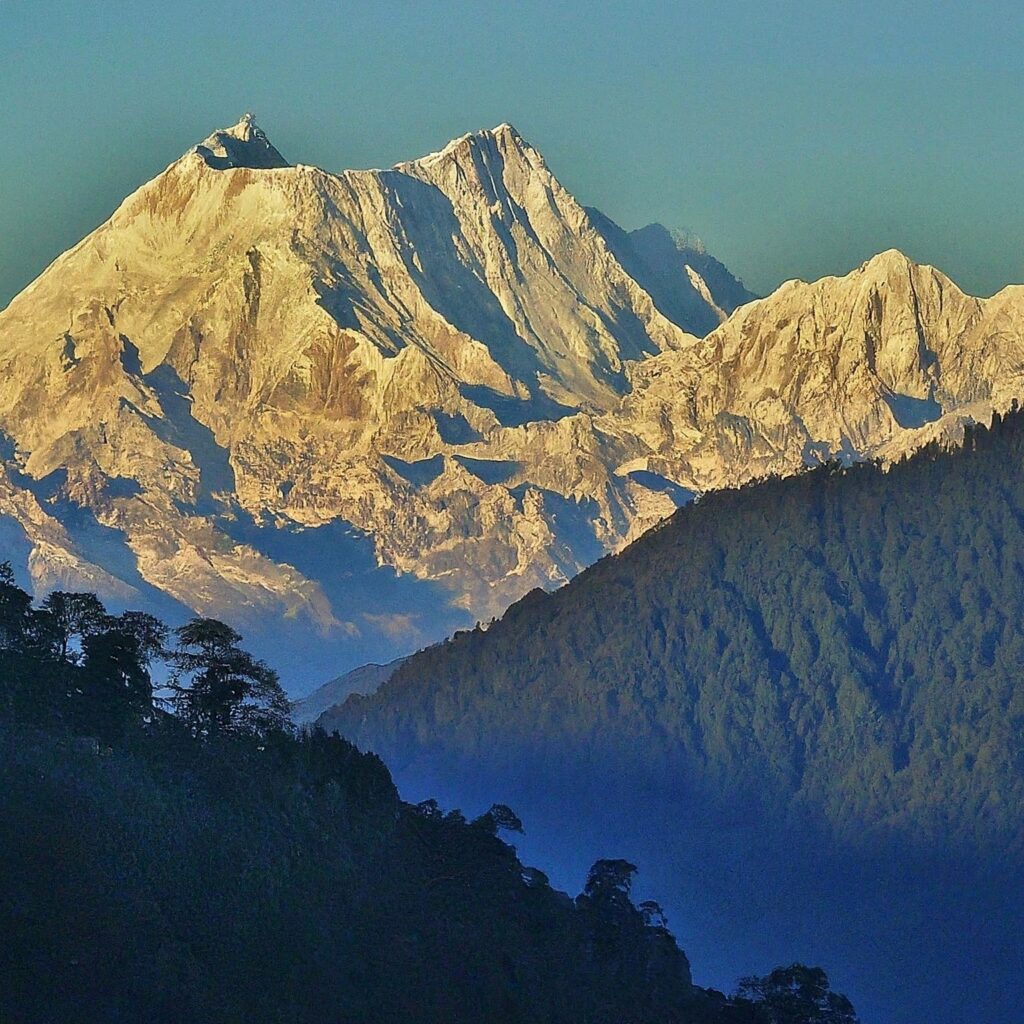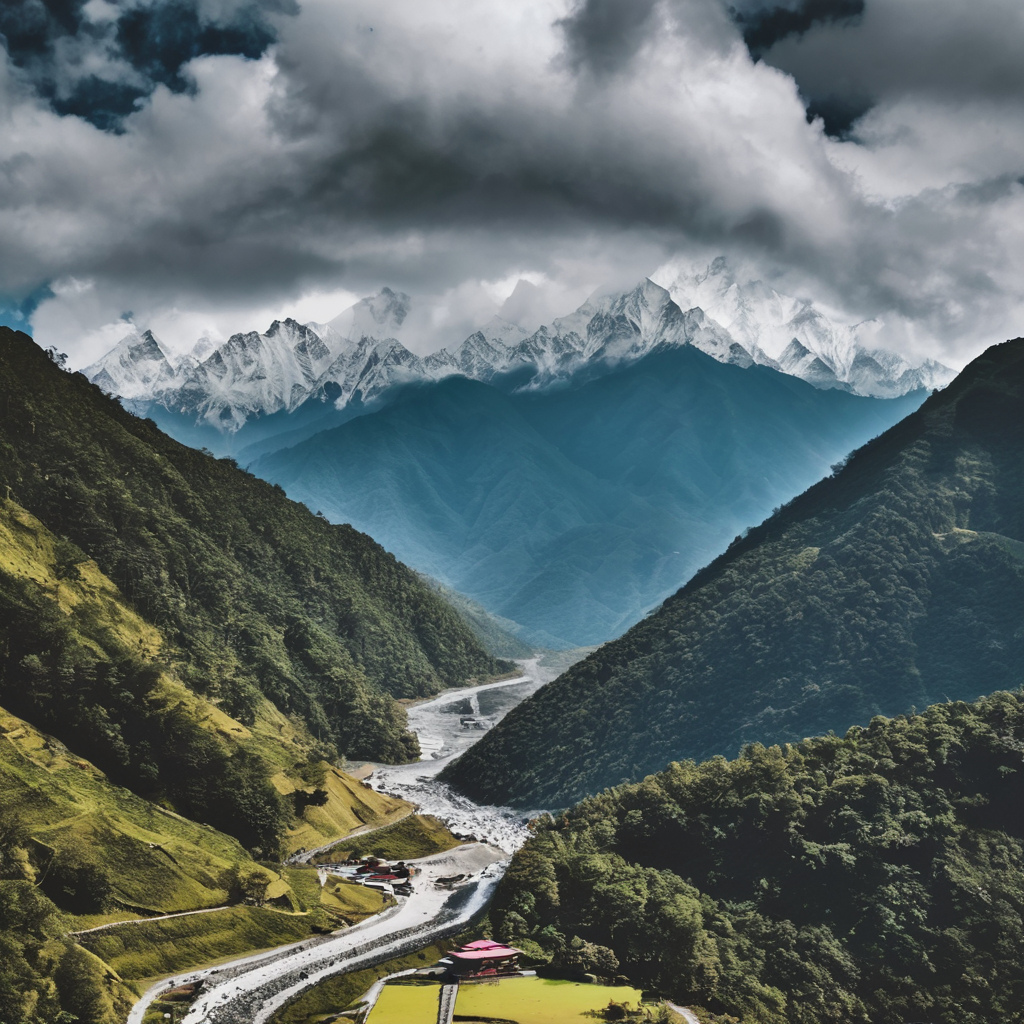“Embark on a journey to Sikkim, where every corner reveals a new marvel of nature’s craftsmanship, from cascading waterfalls to lush alpine forests. Explore the vibrant streets of Gangtok, where the fusion of traditional Tibetan and modern Indian cultures creates a unique atmosphere.”
Delve into the spiritual realm at ancient monasteries like Pemayangtse, where prayer flags flutter in the mountain breeze, echoing with centuries-old chants. Finally, lose yourself in the tranquility of Yuksom, the gateway to the majestic Khangchendzonga National Park, where adventure awaits amidst pristine wilderness and awe-inspiring vistas.

Main Attraction
Sikkim boasts a myriad of attractions that cater to diverse interests:
- Khangchendzonga National Park: This UNESCO World Heritage Site is home to the third highest peak in the world, Mount Khangchendzonga, and offers stunning landscapes, rich biodiversity, and numerous trekking routes.
- Gangtok: The capital city of Sikkim, nestled in the Himalayas, offers a blend of traditional and modern attractions, including monasteries like Rumtek, vibrant markets, and panoramic viewpoints like Tashi Viewpoint.
- Tsomgo Lake: Situated at an altitude of 12,313 feet, this glacial lake is revered by locals and offers breathtaking views of surrounding mountains, especially when frozen during winter.
- Ravangla: Known for its tranquil atmosphere and panoramic vistas of the Himalayas, Ravangla is a perfect retreat for nature lovers, with attractions like Buddha Park, Tathagata Tsal, and Ralong Monastery.
- Pelling: Offering majestic views of Mount Khangchendzonga, Pelling is famous for its serene ambiance, ancient monasteries like Pemayangtse and Sangachoeling, and the iconic Pelling Skywalk.
- Yuksom: The historic town of Yuksom serves as the base for trekking expeditions to Mount Khangchendzonga and is adorned with significant landmarks like the Norbugang Chorten and Dubdi Monastery.
- Namchi: Known for its colossal statues of Guru Padmasambhava at Samdruptse and Lord Shiva at Siddheswar Dham, Namchi offers spiritual solace amidst scenic landscapes.
These attractions represent just a glimpse of the enchanting experiences that await visitors in Sikkim.
Foods to Taste.
Sikkim offers a delightful array of dishes that reflect its diverse cultural heritage and unique geography. Here are some must-try Sikkimese foods:

- Momos: These Tibetan-style dumplings are a staple in Sikkim, filled with a variety of ingredients such as vegetables, chicken, pork, or beef, and served with spicy dipping sauces.
- Thukpa: A hearty noodle soup, Thukpa is infused with flavors of Sikkim, featuring vegetables, meat, or seafood, along with spices and herbs, perfect for warming up in the mountainous climate.
- Gundruk: This fermented leafy green vegetable is a traditional Sikkimese dish, rich in flavor and often served as a side dish or in soups.
- Phagshapa: A popular pork dish in Sikkim, Phagshapa consists of thinly sliced pork belly stir-fried with radishes, chilies, and dried fermented bamboo shoots, creating a savory and aromatic delicacy.
- Sinki: Another fermented vegetable dish, Sinki is made from radishes or mustard greens, soaked in water and then fermented, resulting in a tangy and pungent flavor that pairs well with rice or as a side dish.
- Chhurpi: A traditional Sikkimese cheese made from yak’s milk, Chhurpi is often dried and hardened into a chewy snack or used in cooking to add a unique texture and flavor to dishes.
- Sel Roti: A sweet and crispy fried bread, Sel Roti is made from rice flour and sugar, often enjoyed as a snack or during festivals and celebrations in Sikkim.
- Sha Phaley: Similar to Indian samosas, Sha Phaley are deep-fried stuffed bread pockets filled with seasoned minced meat or vegetables, offering a delicious blend of flavors and textures.
Exploring the culinary delights of Sikkim is an essential part of experiencing its rich culture and hospitality.

Best time to visit.
The best time to visit Sikkim depends on your preferences and the experiences you seek. Generally, the most favorable time for tourism in Sikkim is during the spring and autumn months, spanning from March to May and then from September to November. Here’s why:
- Spring (March to May): This season brings mild temperatures and blooming rhododendrons, making it ideal for nature lovers and trekkers. The weather is generally clear, offering excellent visibility of the stunning landscapes and mountain peaks.
- Autumn (September to November): Another popular time to visit Sikkim, autumn brings clear skies, comfortable temperatures, and post-monsoon greenery. This season is perfect for outdoor activities such as trekking, sightseeing, and exploring the cultural heritage of the region.
However, it’s essential to consider the following factors when planning your trip:
- Monsoon Season: Sikkim experiences heavy rainfall from June to August, which can lead to landslides and roadblocks, impacting travel plans. While the monsoon season brings lush greenery and rejuvenates waterfalls and rivers, it may not be the best time for outdoor activities and sightseeing.
- Winter (December to February): Although Sikkim experiences cold temperatures and occasional snowfall during the winter months, this season has its charm. Winter is ideal for witnessing snow-covered landscapes, enjoying winter sports like snowboarding and skiing in places like Nathula, and experiencing local festivals like Losar (Tibetan New Year) and Maghe Sankranti.
Ultimately, the best time to visit Sikkim depends on your interests and what you wish to experience during your trip. Whether you prefer mild weather for trekking and sightseeing or want to witness the beauty of snow-covered landscapes, Sikkim offers something special throughout the year.
How to go ?
Reaching Sikkim involves a combination of transportation modes due to its location in the northeastern part of India. Here’s a general guide on how to get to Sikkim:
- By Air:
- The nearest airport to Sikkim is Bagdogra Airport (IXB) in West Bengal, which is well-connected to major cities like Delhi, Kolkata, and Guwahati.
- From Bagdogra Airport, you can take a taxi or pre-arranged transportation to Sikkim. The journey from Bagdogra to Gangtok (the capital of Sikkim) takes around 4 to 5 hours by road.
- By Train:
- The nearest major railway station to Sikkim is New Jalpaiguri Railway Station (NJP), which is well-connected to various cities across India.
- From New Jalpaiguri Railway Station, you can hire a taxi or take a shared cab to reach Sikkim. The distance between NJP and Gangtok is approximately 120 kilometers, and the journey takes around 4 to 5 hours by road.
- By Road:
- Sikkim is well-connected to neighboring states like West Bengal and Bihar via roadways.
- You can either drive to Sikkim in your private vehicle or opt for shared taxis and buses that operate regular services between nearby towns and cities.
- National Highway 10 connects Sikkim to Siliguri in West Bengal, which serves as the gateway to the state. From Siliguri, you can proceed towards Gangtok or other destinations in Sikkim.
- Inner Line Permit (ILP):
- It’s important to note that visitors traveling to Sikkim need to obtain an Inner Line Permit (ILP) to enter the state. ILPs can be obtained online or from designated offices in Sikkim, Siliguri, and other locations.
- Local Transportation:
- Once you reach Sikkim, you can explore the state using local transportation options such as taxis, shared jeeps, and buses. Gangtok, the capital city, has a well-developed network of taxis and local buses for intra-city transportation.
Before planning your trip, it’s advisable to check for any travel advisories, entry requirements, and permit regulations, especially if you’re traveling from outside India or during sensitive times.

Travel Tips:
Here are some travel tips to make your trip to Sikkim more enjoyable and hassle-free:
- Obtain Inner Line Permit (ILP): Ensure you have the necessary Inner Line Permit (ILP) if you’re a non-Indian citizen or resident of certain states in India. You can obtain the ILP online or from designated offices before entering Sikkim.
- Pack Wisely: Sikkim’s weather can vary, so pack accordingly. Bring layers, especially if you’re visiting higher altitudes where temperatures can drop. Also, carry essentials like sunscreen, sunglasses, hats, and sturdy walking shoes.
- Stay Hydrated: The mountainous terrain and high altitudes can lead to dehydration. Drink plenty of water throughout your journey, especially if you’re trekking or engaging in outdoor activities.
- Acclimatize: If you’re traveling from lower altitudes, take it easy for the first day or two to acclimatize to the altitude. This helps prevent altitude sickness and ensures a more comfortable experience.
- Respect Local Customs: Sikkim has a rich cultural heritage, so be respectful of local customs and traditions. Dress modestly, especially when visiting monasteries and religious sites, and ask for permission before taking photographs of people.
- Use Local Transportation: Utilize local transportation options like taxis, shared jeeps, and buses for getting around. They are convenient and affordable, especially for traveling between towns and attractions.
- Book Accommodation in Advance: Especially during peak tourist seasons, it’s advisable to book your accommodation in advance to ensure availability and get the best deals. From luxury resorts to budget guesthouses, Sikkim offers a range of options to suit different preferences and budgets.
- Try Local Cuisine: Don’t miss the opportunity to indulge in Sikkimese cuisine, which offers a delightful blend of flavors influenced by Tibetan, Nepali, and Indian culinary traditions. Sample dishes like momos, thukpa, and local teas for an authentic culinary experience.
- Respect the Environment: Sikkim is known for its pristine natural beauty, so help preserve it by avoiding littering and respecting nature. Follow designated trails while trekking and refrain from disturbing wildlife.
- Stay Informed: Keep yourself updated about weather conditions, road closures, and any travel advisories, especially during the monsoon season. Stay in touch with your accommodation or local authorities for the latest information.
By following these tips, you can have a memorable and enriching experience while exploring the breathtaking landscapes and vibrant culture of Sikkim.
Travel Cost.
The cost of traveling to Sikkim can vary greatly depending on various factors such as accommodation preferences, mode of transportation, dining choices, activities, and the duration of your stay. Here’s a rough breakdown of expenses in US dollars (USD) for a basic budget traveler:
- Accommodation:
- Budget guesthouses or hostels: $10 – $20 per night
- Mid-range hotels: $30 – $60 per night
- Luxury resorts: $100 and above per night
- Transportation:
- Shared taxis or buses for local travel: $1 – $5 per trip
- Private taxis for longer distances: $20 – $50 per trip
- Renting a car with driver: $50 – $100 per day
- Food:
- Budget meals at local eateries or street stalls: $2 – $5 per meal
- Mid-range restaurants: $5 – $15 per meal
- Fine dining or upscale restaurants: $20 and above per meal
- Activities:
- Entrance fees to attractions and monasteries: $1 – $10 per person
- Trekking permits (if applicable): $10 – $50 per person
- Adventure activities like paragliding or rafting: $20 – $100 per person
- Miscellaneous:
- Inner Line Permit (ILP): $10 – $20 per person (one-time fee)
- Souvenirs and shopping: Variable depending on your preferences
Please note that these are approximate costs and can vary based on individual choices, seasons, and availability. Additionally, prices may fluctuate due to factors such as inflation and changes in exchange rates. It’s always a good idea to research and budget accordingly before planning your trip to Sikkim.
Sample Daily Budget:
Creating a sample daily budget for Sikkim travel can help you plan your expenses more effectively. Here’s a breakdown based on a mid-range budget traveller:
- Accommodation:
- Mid-range hotel: $40 per night
- Daily cost: $40
- Transportation:
- Local shared taxis or buses: $5 per day
- Private taxis for longer distances: $30 per day (shared between travelers if in a group)
- Daily cost: $5 – $30 (depending on travel distance and mode)
- Food:
- Breakfast at a local eatery: $5
- Lunch at a mid-range restaurant: $10
- Dinner at a mid-range restaurant: $15
- Snacks and drinks: $5
- Daily cost: $35
- Activities:
- Entrance fees to attractions: $5
- Miscellaneous activities (optional): $10
- Daily cost: $15
- Miscellaneous:
- Inner Line Permit (ILP): $15 (valid for multiple days)
- Souvenirs and miscellaneous expenses: $10
- Daily cost: $25
Total estimated daily budget: $120
This sample daily budget allows for comfortable mid-range accommodations, transportation, meals at restaurants, entrance fees to attractions, and miscellaneous expenses. However, actual expenses may vary depending on personal preferences, travel style, and unforeseen circumstances. Adjustments can be made based on your specific requirements and budget constraints. Additionally, it’s advisable to keep some extra funds as a contingency for emergencies or unexpected expenses.









